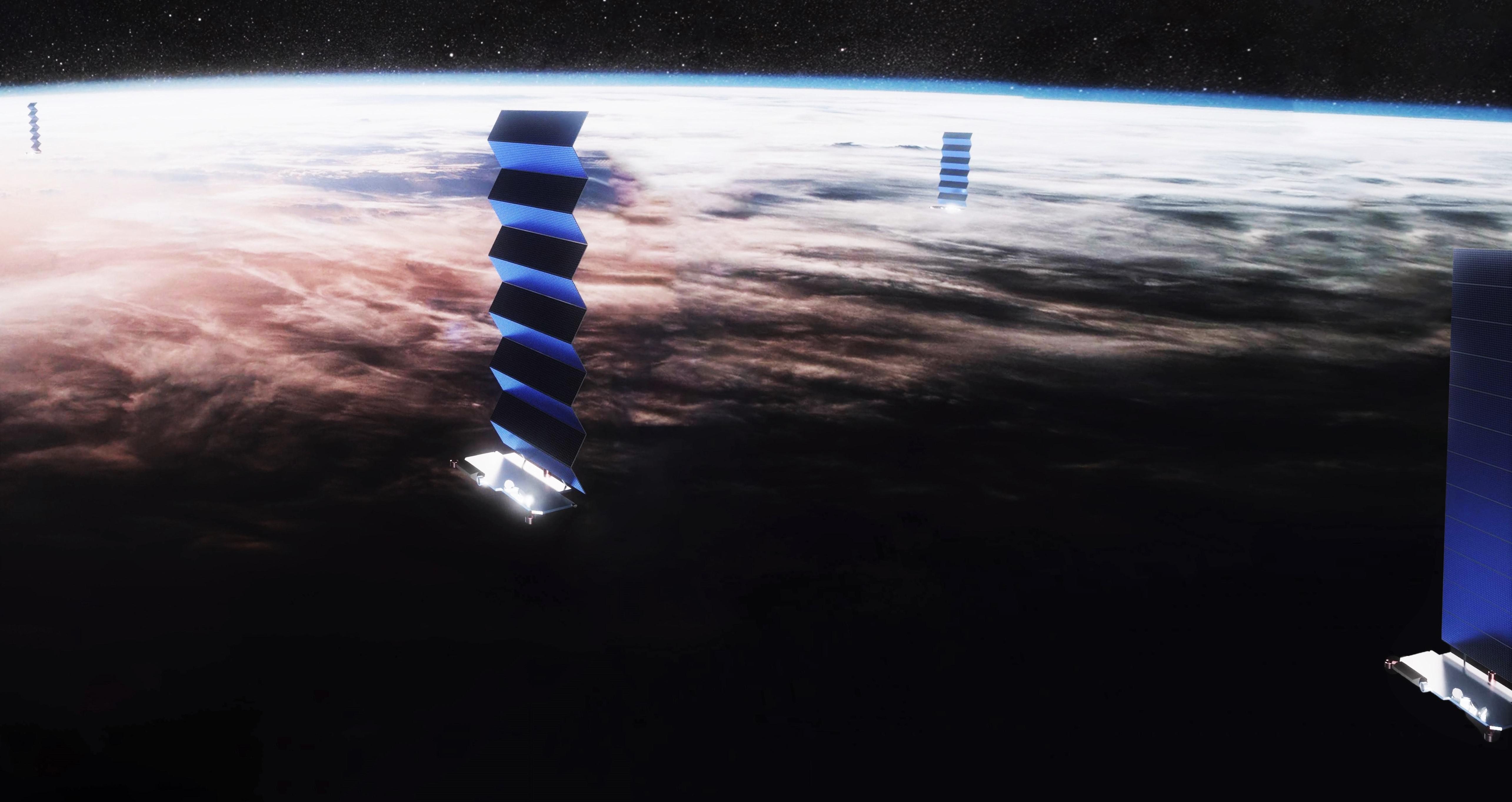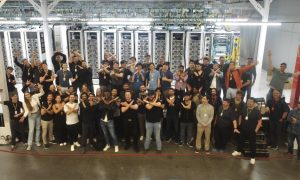

News
SpaceX wants to launch almost 1.5k Starlink satellites next year – that’s a necessity
First reported by SpaceNews, in attendance at the 2019 World Satellite Business Week in Paris, France, SpaceX President and COO Gwynne Shotwell says that the company has plans for as many as 24 dedicated Starlink launches in 2020.
This news comes less than four months after SpaceX’s inaugural Starlink launch – placing 60 prototype spacecraft in orbit on May 24th – and roughly one and a half months before a planned burst of 2-4 more Starlink missions in the final months of 2019. By leveraging the proven reusability of Falcon 9 boosters and probable reusability of Falcon payload fairings, Shotwell believes that the company can simultaneously launch dozens of Starlink missions while still regularly launching customer spacecraft next year.
Extrapolating from SpaceX’s 60-satellite Starlink launch debut, 24 dedicated Starlink missions launched via Falcon 9 rockets would translate to at least 1440 satellites placed in orbit in 2020. In a best-case scenario, SpaceX also wants to launch another four missions before the end of 2019, potentially leaving the company with more than 1700 satellites in orbit by the end of next year.
In roughly 18 months, SpaceX could thus single-handedly almost double the number of functional satellites in orbit – relative to the ~2000 currently under control. Of course, SpaceX is famous for eventually accomplishing almost every problem it sets its gaze on, but not without delays. Even achieving 12 launches – half as many as hoped for – would be a huge milestone, giving SpaceX control of the largest satellite constellation ever launched, capable of supporting an instantaneous bandwidth of ~18 terabits per second (Tbps).
Although it sounds (and is) incredibly ambitious, the reality is that that launch rate is just shy of a necessity for SpaceX to retain Starlink’s two FCC launch and operations licenses. It’s not 100% accurate, as the constellations – one around 1000 km and the other around 350 km – were granted licenses about half a year apart, but SpaceX essentially needs to launch half of its ~11,900-satellite constellation by November 2024. This gives SpaceX a little over five years from the time of this article’s publishing to launch almost 6000 satellites, translating to roughly 3.3 satellites per day or 100 satellites per month.
At 24 annual launches of 60 satellites apiece, SpaceX would average exactly 120 satellites per month, leaving a decent margin for failed or delayed launches and dead satellites. Nevertheless, although it’s extremely unlikely that the FCC would retract SpaceX’s Starlink launches after the company has launched thousands of satellites, those licenses also come with a requirement that the second half of the constellation be launched within seven years of receipt.
In the event that SpaceX manages to launch almost 6000 satellites by November 2024, this means that the company will have to almost double its effective launch cadence to fully complete Starlink by November 2027. It’s safe to say that, short of total corporate dissolution, SpaceX’s next-generation Starship launch vehicle will be operational by 2024, but in the event that Falcon 9 is still the only practical option, SpaceX would need to average almost three Starlink launches per month.
According to SpaceX, approximately a third of those 24 Starlink launches will include a small amount of extra capacity for small satellites seeking affordable access to space. Following demand that apparently far outstretched SpaceX’s anticipated interest in a new Smallsat Program, the company significantly widened its scope and lowered the base price to just $1M for up to 200 kg (440 lb) of cargo, while also announcing that some Starlink launches would include latent capacity. Public schedules show that as many as 9 Starlink missions could feature additional smallsats in 2020, followed by up to 13 in 2021.
Check out Teslarati’s Marketplace! We offer Tesla accessories, including for the Tesla Cybertruck and Tesla Model 3.
News
Tesla launches in India with Model Y, showing pricing will be biggest challenge
Tesla finally got its Model Y launched in India, but it will surely come at a price for consumers.

Tesla has officially launched in India following years of delays, as it brought its Model Y to the market for the first time on Tuesday.
However, the launch showed that pricing is going to be its biggest challenge. The all-electric Model Y is priced significantly higher than in other major markets in which Tesla operates.
On Tuesday, Tesla’s Model Y went up for sale for 59,89,000 rupees for the Rear-Wheel Drive configuration, while the Long Range Rear-Wheel Drive was priced at 67,89,000.
This equates to $69,686 for the RWD and $78,994 for the Long Range RWD, a substantial markup compared to what these cars sell for in the United States.
🚨 Here’s the difference in price for the Tesla Model Y in the U.S. compared to India.
🚨 59,89,000 is $69,686
🚨 67,89,000 is $78,994 pic.twitter.com/7EUzyWLcED— TESLARATI (@Teslarati) July 15, 2025
Deliveries are currently scheduled for the third quarter, and it will be interesting to see how many units they can sell in the market at this price point.
The price includes tariffs and additional fees that are applied by the Indian government, which has aimed to work with foreign automakers to come to terms on lower duties that increase vehicle cost.
Tesla Model Y seen testing under wraps in India ahead of launch
There is a chance that these duties will be removed, which would create a more stable and affordable pricing model for Tesla in the future. President Trump and Indian Prime Minister Narendra Modi continue to iron out those details.
Maharashtra Chief Minister Devendra Fadnavis said to reporters outside the company’s new outlet in the region (via Reuters):
“In the future, we wish to see R&D and manufacturing done in India, and I am sure at an appropriate stage, Tesla will think about it.”
It appears to be eerily similar to the same “game of chicken” Tesla played with Indian government officials for the past few years. Tesla has always wanted to enter India, but was unable to do so due to these import duties.
India wanted Tesla to commit to building a Gigafactory in the country, but Tesla wanted to test demand first.
It seems this could be that demand test, and the duties are going to have a significant impact on what demand will actually be.
Elon Musk
Tesla ups Robotaxi fare price to another comical figure with service area expansion
Tesla upped its fare price for a Robotaxi ride from $4.20 to, you guessed it, $6.90.

Tesla has upped its fare price for the Robotaxi platform in Austin for the first time since its launch on June 22. The increase came on the same day that Tesla expanded its Service Area for the Robotaxi ride-hailing service, offering rides to a broader portion of the city.
The price is up from $4.20, a figure that many Tesla fans will find amusing, considering CEO Elon Musk has used that number, as well as ’69,’ as a light-hearted attempt at comedy over the past several years.
Musk confirmed yesterday that Tesla would up the price per ride from that $4.20 point to $6.90. Are we really surprised that is what the company decided on, as the expansion of the Service Area also took effect on Monday?
But the price is now a princely $6.90, as foretold in the prophecy 😂
— Elon Musk (@elonmusk) July 14, 2025
The Service Area expansion was also somewhat of a joke too, especially considering the shape of the new region where the driverless service can travel.
I wrote yesterday about how it might be funny, but in reality, it is more of a message to competitors that Tesla can expand in Austin wherever it wants at any time.
Tesla’s Robotaxi expansion wasn’t a joke, it was a warning to competitors
It was only a matter of time before the Robotaxi platform would subject riders to a higher, flat fee for a ride. This is primarily due to two reasons: the size of the access program is increasing, and, more importantly, the service area is expanding in size.
Tesla has already surpassed Waymo in Austin in terms of its service area, which is roughly five square miles larger. Waymo launched driverless rides to the public back in March, while Tesla’s just became available to a small group in June. Tesla has already expanded it, allowing new members to hail a ride from a driverless Model Y nearly every day.
The Robotaxi app is also becoming more robust as Tesla is adding new features with updates. It has already been updated on two occasions, with the most recent improvements being rolled out yesterday.
Tesla updates Robotaxi app with several big changes, including wider service area
News
Tesla Model Y and Model 3 dominate U.S. EV sales despite headwinds
Tesla’s two mainstream vehicles accounted for more than 40% of all EVs sold in the United States in Q2 2025.

Tesla’s Model Y and Model 3 remained the top-selling electric vehicles in the U.S. during Q2 2025, even as the broader EV market dipped 6.3% year-over-year.
The Model Y logged 86,120 units sold, followed by the Model 3 at 48,803. This means that Tesla’s two mainstream vehicles accounted for 43% of all EVs sold in the United States during the second quarter, as per data from Cox Automotive.
Tesla leads amid tax credit uncertainty and a tough first half
Tesla’s performance in Q2 is notable given a series of hurdles earlier in the year. The company temporarily paused Model Y deliveries in Q1 as it transitioned to the production of the new Model Y, and its retail presence was hit by protests and vandalism tied to political backlash against CEO Elon Musk. The fallout carried into Q2, yet Tesla’s two mass-market vehicles still outsold the next eight EVs combined.
Q2 marked just the third-ever YoY decline in quarterly EV sales, totaling 310,839 units. Electric vehicle sales, however, were still up 4.9% from Q1 and reached a record 607,089 units in the first half of 2025. Analysts also expect a surge in Q3 as buyers rush to qualify for federal EV tax credits before they expire on October 1, Cox Automotive noted in a post.
Legacy rivals gain ground, but Tesla holds its commanding lead
General Motors more than doubled its EV volume in the first half of 2025, selling over 78,000 units and boosting its EV market share to 12.9%. Chevrolet became the second-best-selling EV brand, pushing GM past Ford and Hyundai. Tesla, however, still retained a commanding 44.7% electric vehicle market share despite a 12% drop in in Q2 revenue, following a decline of almost 9% in Q1.
Incentives reached record highs in Q2, averaging 14.8% of transaction prices, roughly $8,500 per vehicle. As government support winds down, the used EV market is also gaining momentum, with over 100,000 used EVs sold in Q2.
Q2 2025 Kelley Blue Book EV Sales Report by Simon Alvarez on Scribd
-

 Elon Musk2 weeks ago
Elon Musk2 weeks agoTesla investors will be shocked by Jim Cramer’s latest assessment
-

 News3 days ago
News3 days agoTesla debuts hands-free Grok AI with update 2025.26: What you need to know
-

 Elon Musk1 week ago
Elon Musk1 week agoElon Musk confirms Grok 4 launch on July 9 with livestream event
-

 Elon Musk5 days ago
Elon Musk5 days agoxAI launches Grok 4 with new $300/month SuperGrok Heavy subscription
-

 News2 weeks ago
News2 weeks agoTesla Model 3 ranks as the safest new car in Europe for 2025, per Euro NCAP tests
-

 Elon Musk2 weeks ago
Elon Musk2 weeks agoxAI’s Memphis data center receives air permit despite community criticism
-

 News5 days ago
News5 days agoTesla begins Robotaxi certification push in Arizona: report
-

 Elon Musk2 weeks ago
Elon Musk2 weeks agoTesla scrambles after Musk sidekick exit, CEO takes over sales

















